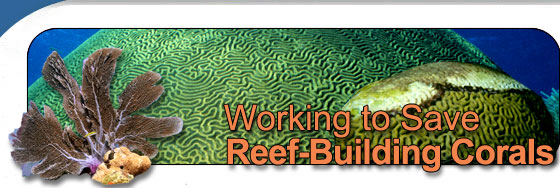Mission Log: September 27, 2007
Geoffrey M. Cook, M.Sc.
Department of Environmental Science and Policy
George Mason University
Living coral reefs are valued as highly diverse ecosystems and as indicators of environmental health in the natural world. Global recognition of the enormous practical value of healthy coral reefs continues to increase in terms of storm protection, food and medicinal production, and tourism revenue. Alarmingly, coral diseases are increasing in range, prevalence, and virulence, subsequently contributing to the enormous damage of reef structures worldwide. Without a clear understanding of the conditions leading to these epizootic diseases, management of these important ecosystems with regard to disease threats will be relegated, mainly, to watching corals die.
 |
|
A colony of M. annularis (complex) exhibiting signs consistent with white plague type II. Samples of coral tissue, skeleton and mucus were acquired during the 2006 FKNMS coral disease cruise. (Photo: Licia Solerno, R/V Nancy Foster.)
|
The complex of diseases known as white plague (WPL) poses a major threat to hermatypic corals in the tropical western Atlantic, the Caribbean, and the Gulf of Mexico. At present, 38 species of coral have been reported to be susceptible to white plague-like (WPL-like) diseases across this broad geographic range. In 1977, Dr. Phil Dustan initially described WPL as a slow progressing, lethal disease of stony corals. Since then, two, more damaging, faster progressing variants of white plague have been identified: white plague types II (WPL II) and III (WPL III). All WPL types present, as a key distinguishing sign, a sharp border separating apparently healthy coral tissue and stark white, recently denuded skeleton (Figure 1). WPL II characteristically initiates infection at the base of a coral colony and moves upward without any discernable “band” or “mat” at rates of 2–10 cm day-1.
If any tissue survives on a colony affected by WPL the coral appears incapable of growing over the denuded skeletal area due to rapid colonization by turf algae. The damage caused by this disease appears to be irreversible. The massive tissue loss associated with WPL and the marked increase in its prevalence over the past decade suggests that WPL is a new disease process rather than merely having gone unnoticed in previous years.
 |
|
A. Triplicate cores of coral tissue and skeleton being collected from an apparently healthy colony of M. annularis (complex). B. A 1.6-cm diameter core tube containing a sample of coral tissue, skeleton and mucus being deposited into a transport container. (Photo: Licia Solerno, R/V Nancy Foster.)
|
Although diseases of hermatypic corals, some of proven or suspected bacterial origin, pose a serious global threat to coral reefs the composition of bacterial communities on healthy corals and colonies exhibiting signs of disease is poorly understood. My research aims to compare bacterial communities associated with corals from reefs within the Florida Keys National Marine Sanctuary (FKNMS) and across the reported geographic range of WPL II.
Working from the NOAA R/V Nancy Foster for the past three years has afforded me the opportunity to visit and survey numerous reefs throughout the FKNMS. Recently, I was able to obtain samples of coral tissue and skeleton from apparently healthy colonies as well as corals exhibiting signs consistent with white plague type II (WPL II) while participating in the annual FKNMS coral disease cruise. Triplicate 1.6-cm diameter cores of coral tissue and skeleton were obtained from three unique reef systems within the Sanctuary’s boundaries: 1) Sherwood Forest, Tortugas Bank, 2) Western Sambo Ecological Reserve, and 3) Looe Key (Figure 2). Total and culturable bacterial communities associated with these samples are presently being evaluated in an effort to develop a clearer understanding of bacteria associated with apparently healthy corals and coral disease.
My thanks go out to the managers and staff of the FKNMS, my peers and colleagues, and the captain and crew of the NOAA R/V Nancy Foster. If it were not for their genuine interest in, and concern for, the growing threat of coral diseases affecting Florida’s reefs, the role of bacteria in coral reef ecosystems would remain an even greater mystery.
|



